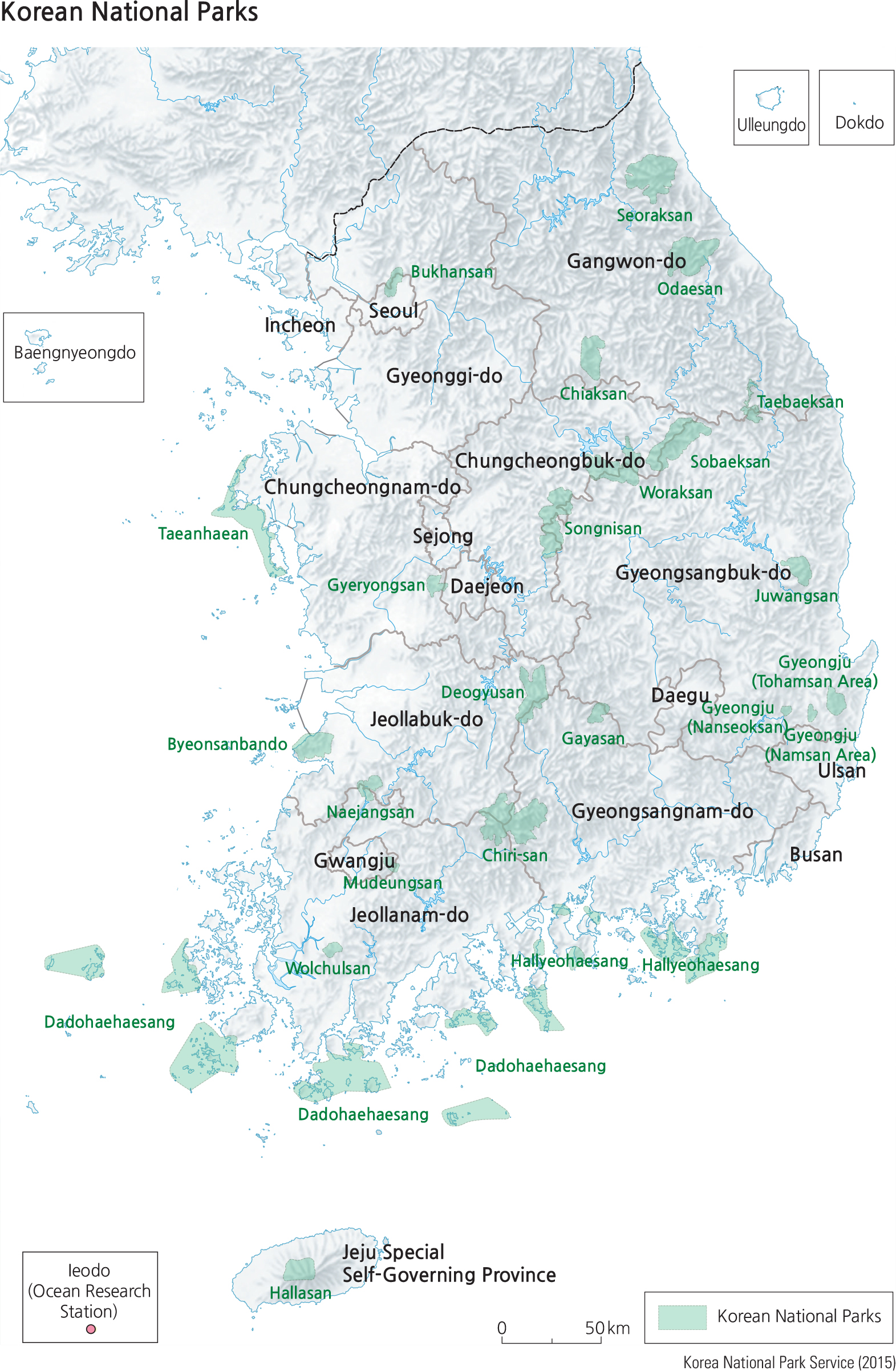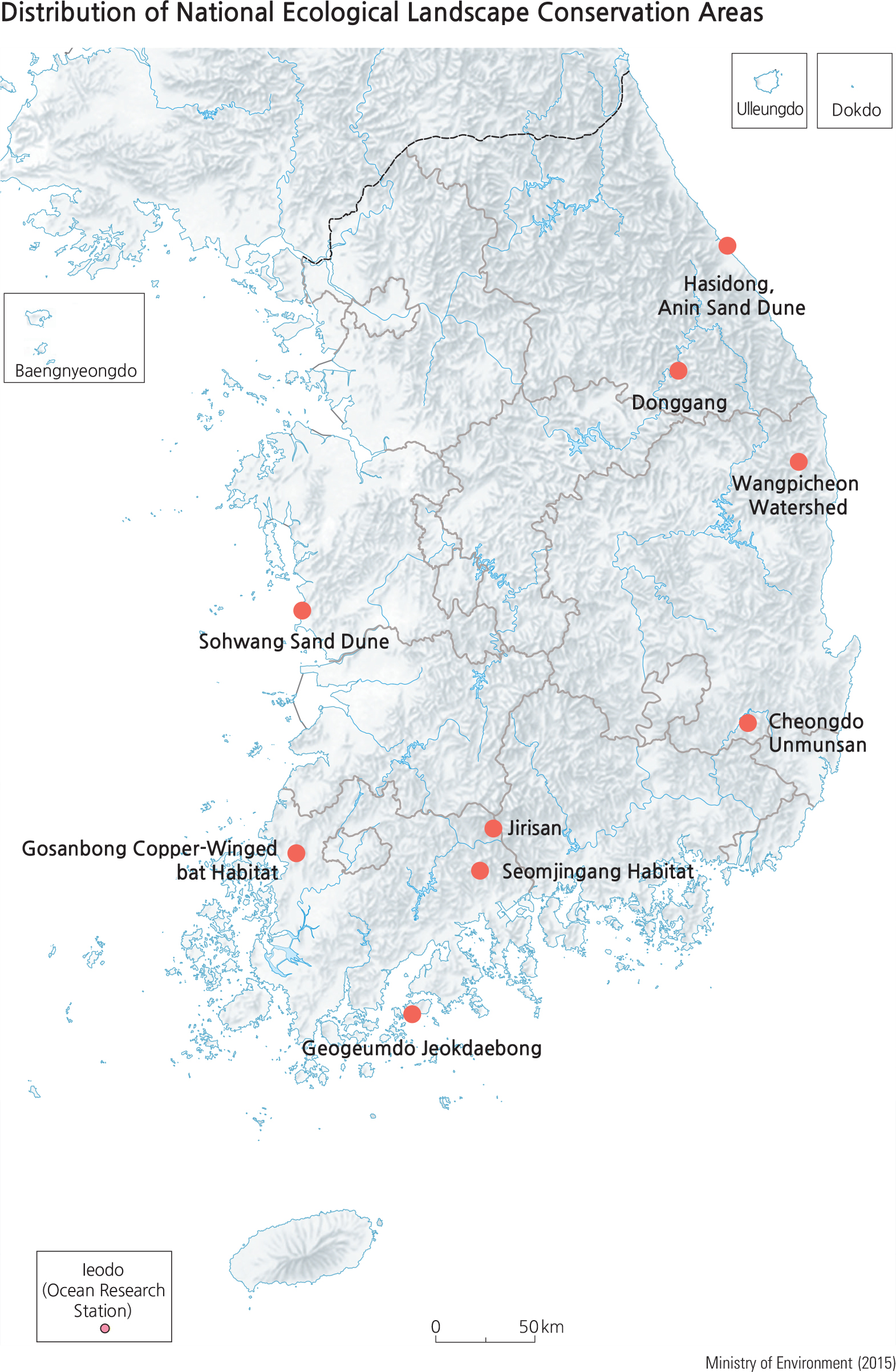The modern concepts of protected areas were primarily implemented in Korea through the establishment of the Forest Act, Parks Act, and Cultural Property Protection Act in the 1960s. Hongdo and Seoraksan were designated as the first nature reserves in 1965 and Jirisan was designated as the first National Park in 1967. There are ten related Acts regarding protected areas in Korea. Three of the ten Acts, the Natural Environment Conservation Act, the Marine Environment Management Act, and the Cultural Property Protection Act deal with general matters of environmental and cultural property protection, regulating relevant provisions for these protected areas. The remaining seven Acts mainly contain provisions focusing on the designation and management of protected areas.
Since the designation of Jirisan National Park as the first national park in Korea on December 29, 1967, a total of twenty-two national parks have been designated and protected. Except for Hallasan National Park, which is managed directly by Jeju Special Self-Governing Province, the National Park Authority (established in 1987) manages all the national parks. The total area of the national parks is 6,653.924 square kilometers, of which 3,969.414 square kilometers are land and 2,684.510 square kilometers are sea. Among the twenty-two national parks, seventeen are associated with mountains, four are coastal, and one, Gyeongju National Park, is urban. Taebaeksan was the last to be designated as a national park on August 22, 2016.
Other than national parks, various regions have been selected and designated as natural parks in order to protect ecosystems and cultural landscapes. Among these natural parks, some prominent examples include provincial and county parks, as well as ecological landscape conservation areas. Provincial parks are representative areas of natural ecosystems and landscapes in metropolitan cities and provinces. By 2016, there were thirty provincial parks designated (with a total area of 1,139.1 square kilometers). County parks are representative of local districts (-si and -gun administrative levels) with a total of twenty-seven currently being operated (comprising a total area of 237.7 square kilometers). Such natural parks increase the value of the natural ecosystems and thereby provide the local community with opportunities for regional development. Lately, provincial and county parks are increasing in area as provincial municipalities are attempting to promote regional development and tourism.
National Ecological Landscape Conservation Areas are chosen and managed based on their geologicalgeomorphologic value, vegetative importance, ecological recognition, or necessity for conservation. These areas present significant values in conservation and scholarly research of biodiversity by maintaining the primitiveness of natural ecosystems. The regions possess distinct geological or topographical characteristics that are protected for sustainability, for research and for scenic values. The areas also represent diverse ecosystems and possess exceptional natural landscapes such as rivers, mountains, and valleys. Nine areas are currently designated and protected across the country.
Brief Interpretation of the Maps
The Baekdudaegan Mountain Range is more than just the principle geomorphologic spine of the Korean Peninsula; it is also a philosophical core of Korean Culture. In many of the maps in this atlas it forms a central pattern of many different data distributions. It is a national treasure where many Koreans aspire to hike. Furthermore, it hosts many elements of Korean terrain, forests and cultural sites, similar to the Appalachian and Pacific Crest Trails in the United States.
The crest of the whole range is almost a continuous chain of National, Provincial, and County Parks and Reserves. The largest units of protected areas are National and Provincial Parks that are distributed around the east and south coasts. However, parks are not concentrated around major metropolitan areas. The smaller preserves are well distributed in most of the sub-districts in South Korea.
Major preserves are not evenly distributed because of the special natural characteristics that distinguish a nature preserve. Philosophically, preserves are for providing areas for rest and mental regeneration as well study and preservation. Do you see a conflict between the designations of the largest parks and reserves in more remote regions, compared to the goal of maximizing urban access to natural areas for rest, study and regeneration? What other characteristics could be useful in defining and locating different types of preserves? Preserves in South Korea tend to be large in area or very small. Can you make an argument for a variety in sizes of preserves?


